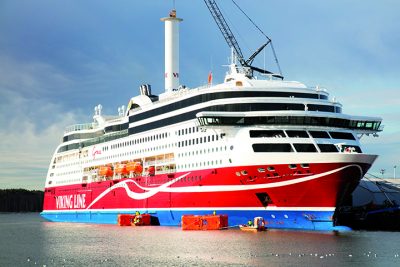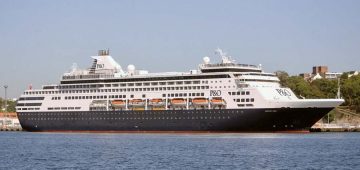Ro-Ro Giant Expands
DFDS announced on 12th April that it has acquired 98.8% of U.N. Ro-Ro, the leading Turkish operator of freight shipping routes in the Mediterranean from Turkish private equity firms Actera Group and Esas Holdings. Connecting Turkey with Italy and France, the company is highly profitable and the leading operator with a market share twice that of the next competitor in Turkey.
Ferries Go Auto
Rolls Royce Marine has signed a deal to supply its innovative Autocrossing system to a total of 13 new environmentally friendly ferries for the Norwegian company Fjord1. The vessels are currently being built by three yards in Turkey and two yards in Norway. All contracts also include two azipull propellers for each vessel with accompanying propeller control system from Rolls Royce.
Color Line Hybrid Takes Shape
The world’s largest plug-in hybrid ship began to take form on 16th April as the assembly of the 14 large blocks commenced at the Crist Shipyard in Gdynia, Poland, with the keel laying ceremony. The environmental friendly ship will be the world’s largest battery-hybrid ship when she enters service between Sandefjord and Strømstad in June 2019.
Grace-Ful Sail-Ing


The 57,565gt/2013 built Viking Grace (above) was transformed into a sail assisted vessel on 12th April. The ship is the first passenger ship in the world equipped with a rotor sail for the utilisation of wind power and the equipment was developed by the Finnish company Norsepower Oy Ltd. Viking Line began operating the Viking Grace on wind-assisted voyages between Turku (Finland) and Stockholm (Sweden) as from 12th April. The cylindrical rotor sail is 24m in height and 4m in diameter and it uses the Magnus effect for propulsion. As the rotor is spinning, the passing air will flow with a lower pressure on one side than the opposite side. The propulsion force created by this pressure difference will drive the vessel forward.
Route Closed & Ship Ordered
DFDS announced on 24th April that the embattled Rosyth-Zeebrugge freight service had been closed. The financial performance of the route, that deploys one ro-ro freight ferry for three weekly round trips, has struggled to meet expectations. Freight volumes are, in general, increasingly being focused on large hubs offering a high frequency of departures deploying larger ferries. As volumes are unlikely to pick up on the route, or be large enough to sustain an efficient operation, the route is no more. The annual revenue of the service in 2017 was around DKK 100m. The final nail in the coffin for the service came on 16th April when a fire broke out in the engine room aboard the Finlandia Seaways, the single ship serving the route, on 16th April. An injured crew member was airlifted to hospital, where he was treated for injuries caused by smoke inhalation. The ship was towed to DFDS’ terminal in Immingham, where the cargo on board was discharged, and where DFDS had the opportunity to carry out an inspection of where the fire took place. It was estimated that repairs would take several months and, with no alternative tonnage available as temporary cover, closure was the only option as the operation would struggle to recover. On the same day as this news arrived, DFDS announced that it has entered into a 10-year bareboat charter agreement with Stena Ro-Ro for a Ro-pax ferry newbuild for delivery in early 2021. This member of Stena’s E-Flexer series will be tailored to DFDS’ requirements for deployment on the Channel. DFDS’ two Channel-routes currently deploy six ferries and the charter is part of the ongoing renewal of the fleet. The initial plan is to replace the oldest of the ferries, the 28,833gt/1992 built and 1,600 lanemetre/1,000 passenger capacity Calais Seaways. The ship was built as the Prins Filip and has since served as the Stena Royal, P&OSL Aquitaine, Pride of Aquitaine, Norman Spirit and Ostend Spirit. The final deployment plan will be announced in 2020. The new ferry will have a considerably higher freight capacity of 3,100 lanemetres and will accommodate around 1,000 passengers.
Newbuilds For Grimaldi
On 26th April the Grimaldi Group signed an agreement for the construction of six Ro-Ro vessels, for a total investment worth over $400 million. The order has been awarded to the Chinese shipyard Jinling, thus consolidating an important partnership with the Neapolitan Group, the world’s leading company in the ro-ro sector. The new vessels, whose delivery is expected as from 2020, will have a length of 238m, a beam of 34m and a gross tonnage of 64,000gt tonnes. The ships will be able to accommodate over 7,800 lanemetres of rolling freight, equivalent to 500 trailers.
New Career For St. Helena
The 6,767gt/1990 built St. Helena has been sold for a new life as a floating armoury, carrying automatic weapons, bullet-proof jackets and night vision goggles, all stored for maritime security operatives. Renamed the MNG Tahiti, the ship will undergo some modifications before sailing to the Gulf of Oman where she will be used to transfer guns and personnel to passing vessels navigating stretches of water tainted by pirate activity. The St. Helena’s final voyage was marked with a public holiday on her namesake island with flag-waving crowds gathering on the rocky coastline to catch one last glimpse of the ship that had delivered them everything from car parts to Christmas turkeys. A flotilla of fishing vessels and yachts flanked the ship with those on board popping champagne corks as plumes of balloons were released into the sky to cheers from St. Helena residents.

Swift Debut
On 27th April Irish Ferries announced the debut of the new 8,403gt/2001 built Dublin Swift fast ferry between Dublin and Holyhead, replacing the Jonathan Swift. This new addition to the Irish Ferries fleet, which is now the largest fast ferry crossing the Irish Sea, will operate at a cruising speed of 35 knots to the same frequency of twice daily return sailings as the vessel it is replacing. The vessel can accommodate 220 cars and 820 passengers and the passenger areas are configured somewhat differently on the inside, being of a single deck design rather than the double deck layout familiar to passengers previously.




Comments
Sorry, comments are closed for this item